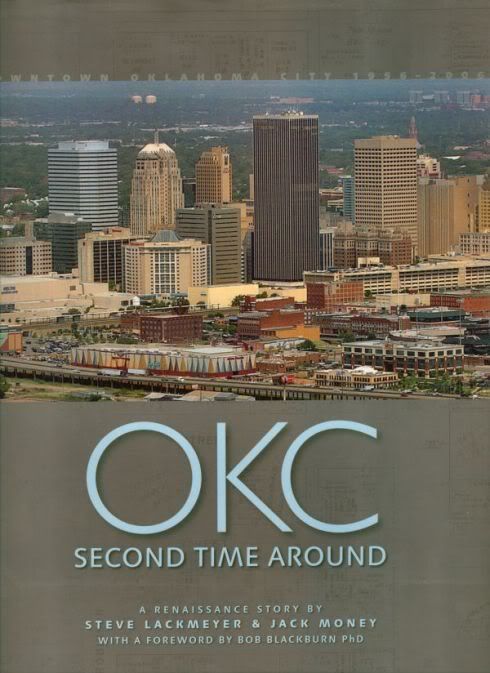
After being reminded (at OkcTalk.com) that I'd missed the event, I went to Full Circle the next day and got two copies, one for me and one for my son. Full Circle Press, owned by the largest independent bookstore in Oklahoma, Full Cirle Bookstore, is the publisher, but more about that in my amended post.
After numerous acknowledgments, the book begins with a magnificent 2 page "Foreword" by Bob Blackburn, Executive Directory of the Oklahoma Historical Society.
The Chapters are: (1) Urban Renewal, (2) "Downtown of Excellence", (3) A New Downtown, (4) Urban Renewal's Demise, (5) Neal Horton, (6) Big Plans, (7) The Crash, (8) Bricktown's Second Chance, (9) "Downtown is dead, and we helped kill it", (10) Visions of a New Frontier, (11) Swing the Vote, (12) An Unexpected Challenge, (13) Butchering the Steer, (14) A Real Life SimCity, and (E) Epilogue.
Why did I buy two copies? It's quite simple ... I don't want to share! This book is that great! The "complete" post I'll make here tells you why I think that way.
In this intial edition of this post, I'm just going to give an overview without lots of words ... that will will come later when I have time to edit this post to give it the meat that a good review of this book deserves.
A QUICK OVERVIEW
This post will be edited after I get back from the Oklahoma Bar's Association's convention in Tulsa this weekend at the latest ... but this is a quick look ... and treats you to some eye candy ...
Steve and Jacks' book is absolutely magnificent from the vantage point of one who enjoys Oklahoma City history. OKC, Second Time Around, A Renaissance Story, covers the 1956-2006 period of time.
The back cover jacket somewhat describes part of the time span covered ...
Downtown is dead and we helped kill it. There is no major retail, no major attraction and no place to eat. -- Oklahoma City Councilman I.G. Purser, April 17, 1988
... today Oklahoma City's downtown is thriving. The Bricktown district is buzzing with nightlife, people are moving downtown ... add to that two successful stadiums, a performing arts center, a central library, a "Riverwalk" type canal, clubs and restaurants, and the downtown of the once-sleepy city ... is bustling. -- Wall Street Journal, April 13, 2005Inside the book are outstanding images Doug Dawgz eyes have never lusted over before ... too many to mention, but a few that stand out are ... Interior of the Criterion Theater (p. 5 and absolutely gorgeous), detailed images on what was proposed in the original Pei Plan, including drawings of the kinds of buildings we would all like to have seen develop but did not, and many others ... and, personal to me, an image on page 55 of my former boss and present friend (and godfather of my outstanding son), lawyer Bill Peterson, but as a sculptor who poses with a bust of Charles Colcord he made for the lobby of the Colcord Building (p. 55).
But, there is so much more ... and the book is well indexed and tells the text story so very well of this period.
Bill Peterson's godson's name is David, my very own son, and I'm right proud of my little boy (though he is much bigger than me, these days)! I enjoyed the Horents Okc home opener a week ago today with him and my great grandson, Tyler ... an experience which would not have been possible but for events described in this book.
BUT, WAIT ... THERE'S MORE! It was my distinct pleasure and honor to have a terrific hour+ long conversation with Steve Lackmeyer last week and we discussed lots of Okie City junkie stuff ... life doesn't get any better than that (except for taking your son and grandson to a Hornets game, of course)! To be sure, we discussed his great book ... oh, I'm getting ahead of myself ...
MY RATING: 5+++ stars ... a superior contribution to Oklahoma City historic stuff. I'll get into the detail of why I say this when I amend this post.
But, for now, some eye-candy ... Steve gratiously allowed permission to post the following images ... others, he was not able to grant since the privilege was not his to give ... but I think that you will like those that follow, all from OKC Second Time Around ... all courtesy of OKC The 2nd Time Around (Full Circle Press 2006) ...
In the pics below, click a pic for a larger image most of the time ...
Credit OKC Urban Renewal Authority
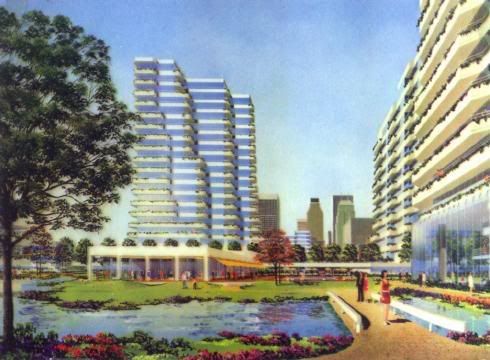
Tivoli Gardens As Contemplated By Pei Plan (p. 39)
Credit OKC Urban Renewal Authority

Overlook of Pei Plan Suggestions (p. 45)
Credit Greater OKC Chamber of Commerce

Carrozza's Plan for the Galleria Gateway (p. 62)
Credit OKC Urban Renewal Authority
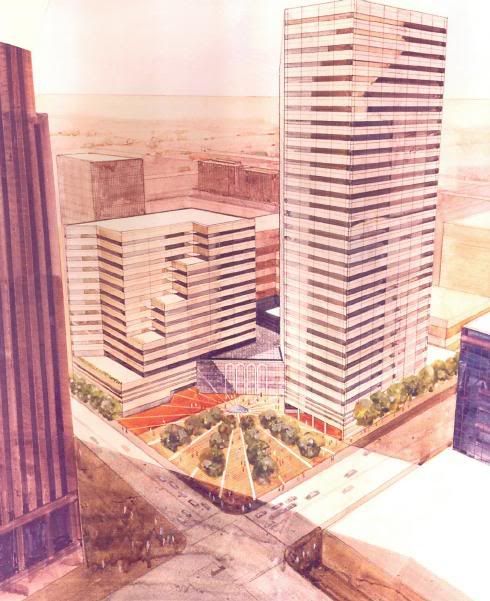
(No enlargements in the following 5 pics)
The 1st pic is similar but not identical to an image at p. 68 of the book.
This shows a postcard of an artist's rendering of what Bill Skirvin originally contemplated for the Skirvin Tower (now 101 Park Avenue Building). It was originally planned to be 26 stories.
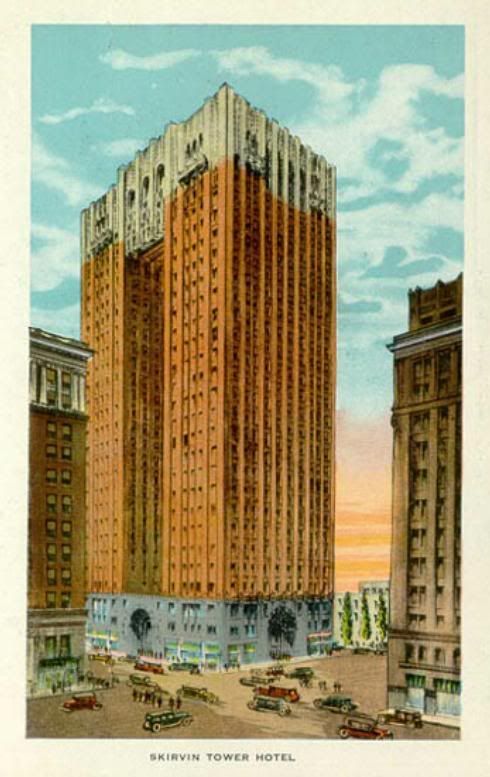
But, that was before the Wall Street Crash. After construction started in 1931, resources dwindled, plans were scaled back, and constrution on the actual building was finished in 1936 at 14 stories, as shown in the postcard below (not shown in the book).

The authors point out in Chapter 6, "Big Plans", that the building's owner contemplated reviving Bill Skirvin's original plan to add 14 floors. But, again, economic circustances -- this time the Oil Bust -- would change the plans. The pics below from the book show what actually happened.
Skirvin Tower Being Stripped To Its Core in the 1970s (p. 68)
Credit OKC Urban Renewal Authority
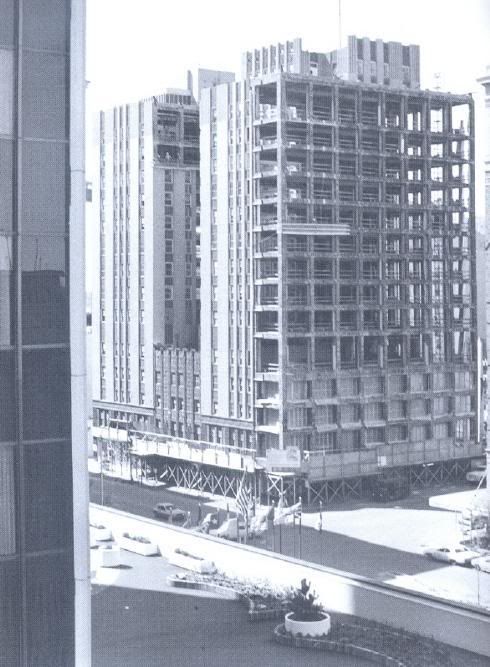
What Was Contemplated ... 14 New Stories
Credit Greater OKC Chamber of Commerce
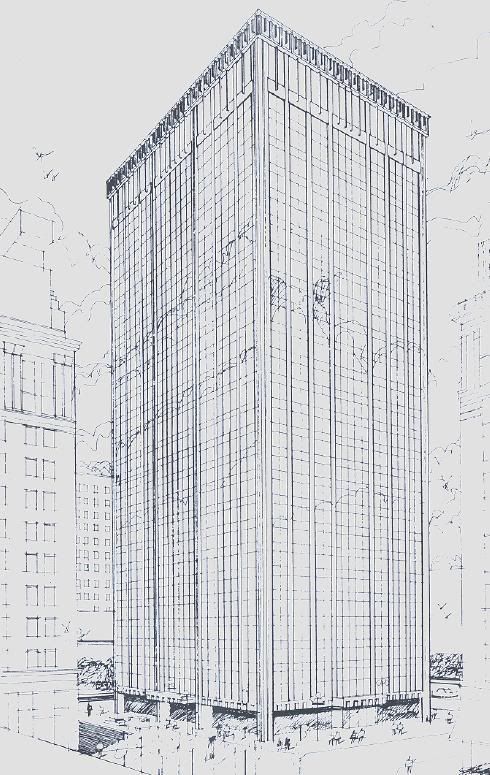
What Happened Instead, After the Oil Bust
A Quality Building, But No New Stories
Credit Greater OKC Chamber of Commerce
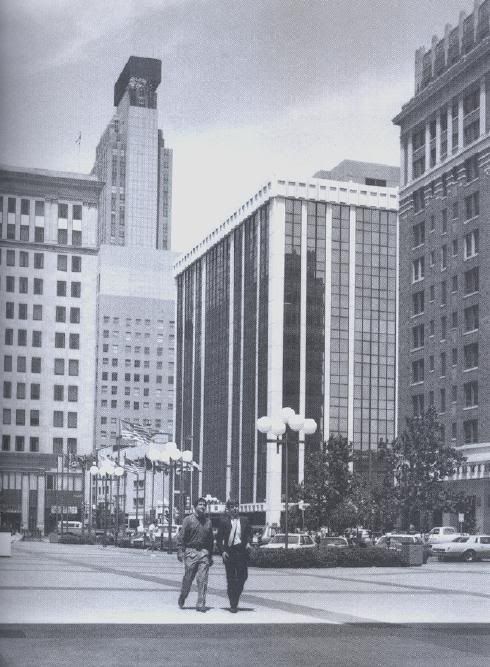
There's lots and lots more ... stay tuned ...!
Check out the book's web blog right here!
[Edited Post to Contain the Detail]
I just couldn't put this down so I'm posting my "amendment" before I leave town later in the morning to go to Tulsa. I am consumed by the stories these guys have to tell in their book, and it would not be right to put it down but for the most exigent cause. Since none exits, here is the detail.
MORE DETAILED REVIEW
Generally: 1st, it should be noted that the book has "large" high quality "slick" pages ... it's a "coffee table" (large) sized book. The images contained in the book are generously large, and the text size (font point size) is generously small – I'd guess about 8 point, maybe 7 point, font size. That means lots of room for words in the 196 Arabic pages plus several Roman numeral pages in the first part of the book. That's good for those who want "just the facts, mamn," and lots of them, as do I.
So, although lavishly illustrated with gorgeous images throughout, this book isn't just "pretty", it is a true and serious "history" book which details the activity associated with downtown Oklahoma City as to events occurring from 1956 forward to the present day. You'd be doing yourself a disservice to leave it laying on your coffee table without a close read or to just skim though the pretty pictures.
Chapter 1 – Urban Renewal. This chapter begins in 1956 discussing a DC-3 flight from Oklahoma City to Washington, D.C., and involving several of Oklahoma City's "movers and shakers." It was a trip involving prospects for Oklahoma City's growth, particularly the downtown area. This was a time that downtown was still alive – John A. Brown's, the Criterion, etc., all shown with good images. It was also a time that suburban shopping centers in Oklahoma City got their start – Penn Square Mall, Shepard Mall, and a time that downtown started to experience diminishing numbers of people who were willing to go downtown instead of visiting the expanding suburban places to shop ... and/or go to the movies. The concept/term "urban renewal" started to raise its head. Mayor Jim Norick won the 1959 mayoral race on a platform favoring "urban renewal."
Chapter 2 – Downtown of Excellence. This chapter describes the city's relationship with I.M. Pei, described as an "internationally renowned urban planner and architect," and the urban renewal plan which emerged. It also describes Pei's words of caution about providing "new" locations for existing commerce before the old buildings would be razed, e.g., John A. Brown's. Some of the magnificent drawings associated with the plan have been shown in the Introduction part of this post.
Chapter 3 – A New Downtown. This chapter steps into the early stages of the demolition phase of urban renewal as well as social changes going on at the same time – namely, race relations. In the late 1950's - early 1960's, downtown (as well as "all" town) was the scene of our Black citizens stepping up to the plate and saying, "It's been too long ... " It also describes the effective respect if not collegiality, of sorts, between civil rights activists and the Chief of Police ... during this period of social change. The chapter discusses accomplishments during this time ... convention center, some new skyscrapers, the Mummers Theater.
Chapter 4 – Urban Renewal's Demise. Lots of stuff had been blown up, but where was that which would take its place? The politics of the time receive considerable treatment, particularly he Oklahoma City Urban Renewal Authority, its history, status, development. There is much more – the drive of Dean A. McGee being especially noteworthy. Dallas developer Vincent Carrozza steps into the mix as a hoped-for developer to get things going, particularly the planned retail "Galleria" which, as we all know now, never happened, even though the Oklahoma Tower and Corporate Tower did. But, Carrozza also wanted to level the Cravens Building (originally Perrine, now Robinson Renaissance) as the "gateway" for the Galleria. The chapter describes why and how that did not occur.
Chapter 5 – Neal Horton. Actually, Neal Horton's "story" spans chapters 5 through 8 in its entirety in telling the poignant story of this Oklahoma City visionary. Chapter 5 describes his background and how "Bricktown" came to have that name, after he had purchased the Colcord. With the "oil boom in full swing and huge swaths of land yet to be developed, downtown's remaining buildings were 99% full." Into this time emerges Neal Horton, at least the "spiritual" founder of "Bricktown," though he would not live to see what you and I have come to enjoy. The chapter talks about Horton's plans/thoughts of turning the Colcord into ... a hotel ... and not just the "one-winged" hotel that we know about, but the "two-winged" Colcord that Charles F. Colcord had originally planned (and, note, Colcord originally intended the building to be what it has finally become ... a hotel). Bill Peterson, too, was interested in "Bricktown" development. The chapter tells the story of how their parallel plans merged and of some initial successes and developments and visions for the future. Early day plans by J.D. Lobb for the re-development of "Automobile Alley" are also described, all of this during the tenure of Andy Coats as Oklahoma City Mayor.
Chapter 6 – Big Plans. The economy was still going gangbusters and some plans were grandiose. The "Conncourse" got developed – Kerr Park on the south side of the Kerr-McGee Building did, too. One of the more ambitious plans was to revitalize Bill Skirvin's plan for the Skirvin Tower, to add 14 stories to the building as had originally been contemplated. Money was flowing, and apparently being willingly spent on things that might be.
Chapter 7 – The Crash. This chapter describes how such prospects changed – Penn Square Bank, the Oil Bust, etc. A beautiful picture a page 73 (sorry, I have no permission to show it) shows a gorgeous planned office tower to be built next to the Skirvin Hotel in the late 1970's. Ron Burks wanted to build a 17 story Hilton Hotel overlooking the Myriad Gardens (sorry, I have no permission to post this beauty ... guess you'll have to buy the book!) which would have been in rounded glass design to match the planned botanical tube of the Myriad Gardens. While some developments did occur (a scaled down Sycamore Square, sans high rise), Leadership Square, the Arts Council of Oklahoma City finding its permanent home on Hudson, and the Myriad Gardens for which we have principally Dean McGee to thank, other plans bit the dust. Carrozza insisted on the Cravens being destroyed to make a "gateway" into the "Galleria" before he built the Oklahoma Tower and Corporate Tower, and then exited Dodge Oklahoma City.
Chapter 8 – Bricktown's Second Chance. Even after Penn Square Bank being closed by federal authorities, and the domino closing of very mighty local and other banks, including First National, Neal Horton was not an immediate victim and he hung fast with his vision for Bricktown. But, things were not good. Even though, "Bricktown remained his consuming passion," resulting foreclosure lawsuits eventually occurred, and, eventually, all became lost to Horton. Not only Bricktown, but his wife (divorce), and, ultimately, his life.
Horton's financial failure pretty much marks the point that Jim Brewer and others, notably Don Karchmer, step into the mix. Even though Horton had attempted to persuade Spaghetti Warehouse to open a Bricktown location in 1982, it didn't happen until Horton was out of the picture, in 1989. The chapter has some fascinating stories about Mr. Brewer and how he became involved with all of this, including his O'Brien's, his insistence on a flagpole as part of a deal to involve KFOR-TV in a 4th of July event/parade, and how the flagpole actually got built by "grit", I guess one would say.
The chapter describes the opening of the Myriad Gardens, shortly before it's principal promoter's death (Dean A. McGee).
All this said, my subjective emotional focus is clearly the story told about Neal Horton which began in Chapter 5. Though it's a vast oversimplification for me to say, the book clearly portrays him as a visionary and one determined to succeed in developing Bricktown but who never did ... but not because he didn't give his vision all he had. Developing financial, health, and marriage issues, shortly before his death, the book describes how, near his end, he was homeless. Only with the financial assistance of some friends during the last months of his life would he even have a roof over his head.
The following quote picks up during this same time ... Bricktown had turned the corner ...
The city, which for years had refused to participate in any Bricktown improvements, finally chipped in $444,000 toward improving sidewalks, curbs, and landscaping. Brewer, Tolbert, and Karchmer had also worked with the city to create an urban design committee to oversee building facade renovations. Despite his bad health and vanished fortune, Horton still presented himself with class when accepting visitors. He still wore the freshly pressed white shirts, a habit from his days he could not quite shake.Horton's story smacks me as being the stuff of a modern day Shakespearian tragedy. You've gotta like this classy guy ... and you've gotta cry.
On a cold December day in late 1992, Karchmer visited Horton at his Seven Oaks Apartment. "The first nice spring day, I'm going to come get you, bring you down to Bricktown and drive you around," Karchmer said. Horton agreed - he was eager to see the old warehouses again. Horton, however, did not make the trip. Before then, he made one last trip to the hospital, where he finally succumbed to the emphysema that had dogged him since Bricktown had slipped from his grasp.
In his dying days, even Horton could not imagine was next for Bricktown ...
Oh, yeah, these guys really know how to tell a story.
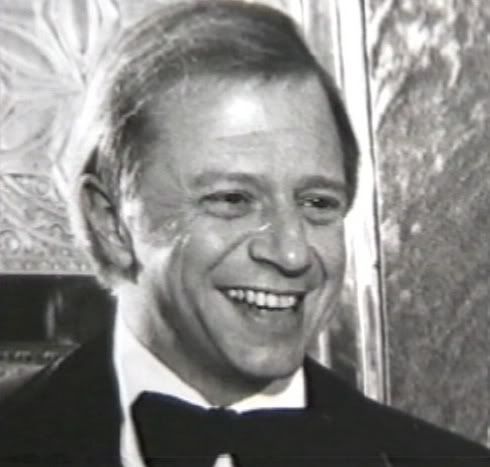
Chapter 9 – "Downtown is dead, and we helped kill it." Chapter 9's quoted text is form a statement made by Councilman I.G. Purser in 1988, alluding to the destroyed-but-not-replaced buildings largely along the south side of downtown, the loss of downtown's retail commerce, eateries, movies, and just about anything that is just plain fun for a person to do. Surveys showed that Oklahoma Citians had a low opinion of their city and its government and that many if not most would live elsewhere, given the opportunity.
Chapter 9 begins the remarkable story of how Ron Norick, elected mayor in 1987, turned that seemingly unchallengeable tide. One is left with the impression that, if he did not do that single-handedly, without him it is most likely that the tide would not have been turned at all, at least not within our lifetimes.
In political parlance, Oklahoma City is not what is called a "strong mayor" form of municipal government. See Mayor-council government - Wikipedia, the free encyclopedia if you want a mini-course about that. Even so, reviewing the period of time between 1987 through the end of Mayor Norick's second term in April 1998, the authors leave no doubt that Mayor Norick knew what had to be done and that he was willing to risk his political position to at least attempt to accomplish it. Urban Renewal had stalled out and, in many substantial ways, failed, and downtown Oklahoma City was continuing to wither on the vine as a place that people would want to be and/or go after 5:00 p.m., Monday through Friday, and/or at any time during weekends.
Sure, several new buildings resulted from Urban Renewal before the Oil Bust, the fall of Penn Square Bank and the ensuing series of bank failures which rippled not only through Oklahoma but the country – Kerr-McGee Tower, Oklahoma Tower, Murrah Federal Building, Fidelity Bank, Leadership Square, Corporate Towers, Myriad Convention Center, Myriad Gardens, and some others, but, notwithstanding, a desolate and vast hole existed between much of downtown south of Park Avenue to Interstate 40 and that area's environs, excepting a place here or there (e.g., Myriad Gardens). In some limited ways, Oklahoma Citians had been willing to tax themselves – e.g., for zoo improvements but not for library and other public needs.
Chapter 9 might be seen as sort of Mayor Norick's "learning" phase – he spearheaded efforts to locate a major United Airlines Maintenance facility here – close but no cigars as Okc lost out to Indianapolis, among other failed initiatives.
Why were we close but always losers, the mayor wondered. "When people hear of Oklahoma City, they just draw a blank," he concluded. "People just don't have a clue about who we are. I just think that we have got to do something."
Chapter 10 -- Visions of a New Frontier. Chapter 10 is sort of a "catalyst" chapter. The Oklahoma City Chamber of Commerce and the mayor had similar if not identical notions of what was needed to turn the tide. Not without dissension, the mayor knew his head and forged ahead, putting together a task force of both those who he thought might be adversaries and not, their purpose being to come up with a grand plan. A principle of Norick's vision was "mass" -- for most of the projects to be centered downtown so that one project could feed off of one another ... some elements of which were contrary to the wishes of formidable Oklahoma Citians and/or interests, e.g., E.L. Gaylord wanted a new arena at the Fairgrounds, some wanted a totally new cultural center and not just an updated Civic Center Music Hall, etc., etc., etc. However, Mayor Norick, firmly involved in the process, held his ground. Of course, other projects were also involved ... upgrading the Convention Center, a new library, river improvement and development through south of downtown – and – canals and stuff in that ignored part of town that Neal Horton's dreams were hooked upon, Bricktown.
Mayor Norick wanted to proceed forthwith to put the grand design to a vote of the people, asking them to impose a penny sales tax upon themselves for five years to pay for the privilege!
Prior polling suggested passage to be unlikely. "The numbers, Deck and other task members decided, were bad, and almost everyone at the table the election might need to be postponed, at least until after the next mayoral election in March 1994. Instead of going along, Mayor Norick became increasingly adamant that the election needed to be held soon. "You know what?" Norick told the group. "I don't want to be mayor if we don't at least try to do this. If we take a shot at this and it doesn't pass and that in results in me not being re-elected, then so be it."
Chapter 11 -- Swing the Vote. This chapter involves the efforts of getting people on board so that the vote might succeed, and how it happened. It was not always easy.
Newspaper publisher Edward L. Gaylord was among the skeptics. "You must be crazy," Gaylord responded after hearing the plan. "You'll never get it passed. And besides, that canal is the dumbest thing I've ever heard of."
But, others like Joel Levine, conductor of the symphony, made speeches supporting a new ball park for the city, and sports enthusiasts talked about the importance of bringing musicals and opera to the town.
As he campaigned, Norick remained focused upon the plan as a whole and what he felt it would do for the city. "Are you willing to defeat your symphony because you don't like baseball?" Norick asked arts patrons. He also rallied the senior vote, telling older city residents the plan was about the future. "You may not like it. You may not even be around for it. But, aren't your grandkids?"
Rick Horrow, paid Florida based consultant but catching the fever, called the plan, "the boldest he had ever seen by a city to improve itself by dramatically raising the quality of life of its residents." Attendants at a December 1993 Myriad Convention Center rally were counseled by Coach Barry Switzer: "'The ball is on the one-yard line,'" Switzer screamed, closing out his talk in a manner he might have used with his players a time or two. "Let's put it in the end zone ... and then we'll be number one in the twenty-first century! You have got chance to make a difference, damn it! Do something about it!'"
Dirty tricks, all! But with these tactics and against all odds, the initial MAPS vote passed.
But, would it happen?
Chapter 12 -- An Unexpected Challenge. This chapter describes the singular most horrific event to occur in our city, the Murrah Bombing. You know about it. I know about it. I still don't like focusing on it, so I'll indulge myself here and pretty much skip it, except to say that the words and graphics are as excellent as verbal and visual description can said to be upon such a topic. Sorry ... best I can do.
Chapter 13 -- Butchering the Steer. This is perhaps the most agonizing chapter in the book. It describes the infighting and politics that somehow managed to spit out a finished product. I'm not a fan of fiefdom's and self-interest and such things, so I did not like this chapter, even though it was necessary to the story.
In addition to the above, the public was becoming anxious as time went on with no dirt turned. Even sports writers like John Rhode got into the act:
Obviously, we all want MAPS to be handled correctly. But let's pick up the pace. How 'bout it, MAPS people? Sign some contracts. Dig a hole. Move some dirt. Lay some concrete. Plow down the old. Start building the new. When can you start? Sometime yesterday would be nice.It didn't help that "supporter" Ernest Istook, who was in a Congressional position to make a difference, opposed the plan's light rail element, favoring instead bus-like trolleys. It didn't help that erroneous reporting occurred in the Oklahoman about the depth (reported to be a mere 14") of the Bricktown Canal. It didn't help that the NHL turned down Oklahoma City's bid to be an expansion team (but, personal privilege here taken, "Thank you, God!")
But, John Q. Hammons did take notice of what was going on and announced that he would build a hotel north of the Myriad Convention Center (the Renaissance Hotel).
In all of this, this reader is left with the unmistakable impression that Ron Norick was a maestro in presiding over diversity, chaos, unmet schedules, but, more, putting a vision before the city and encouraging them to dream ... sounds something like a Neal Horton with a bully pulpit, doesn't he?
Mayor Norick did not seek another term of office. Before his term was done, it was evident that construction costs and/or perhaps revenue generated (maybe both) did not result in these two items of the equation being equal: Cost to Do = Resources at Hand. So, what to do? Clip the sports arena (Ford Center)? What?
Councilman Frosty Peak said, "Absolutely not!", as to asking the city to impose an extension of the penny sales tax for 6-8 months to a year. The council did not act before Norick's term expired.
The ensuing campaign mainly pitted Guy Lieberman, the front-runner, who would scrap the sports arena, against Kirk Humphreys, who campaigned on a message to "Finish MAPS Right." He said, "By golly, we've come this far – let's finish it first class." In the runoff, Humphreys won hands down, 69% to 31%.
After the election, more than 13,000 fans attended the Bricktown Ballpark for its opening as outgoing Mayor Ron Norick threw the opening pitch.
In the process, many longtime residents rediscovered downtown for the first time in years. "This is a great place," said Jason Lively, a south Oklahoma City resident. "But I didn't know how much work they've done here. I'm going to come back more often." "MAPS is really doing the trick," agreed James Chenney, an accountant who worked downtown.Chapter 14 -- A Real Life Sim City. The introduction on page 159 pretty much tells the tale and all that follows:
First-time visitors to the park were surprised by its quality. As they walked the park's concourse, they were seen alternatively grinning from ear to ear and then looking around wide-eyed like a five-year-old child who just got his first bike for Christmas.
The public's attitude towards MAPS clearly had been in the upswing as the countdown began for the opening of Southwestern Bell Bricktown Ballpark. The cynicism had faded, replaced by a new enthusiasm not just for the projects themselves, for all of downtown.
But, the holdover issue, whether to put to yet another vote of the people to continue to tax themselves a bit longer for the sports arena, proper funding for the convention center, fairground and river projects, had not been decided by the council to be put to a vote of the people.
Despite lingering controversies, Humphreys and allies at the Greater Oklahoma City Chamber of Commerce were growing confident they might persuade the public to extend the MAPS tax just enough to "Finish Maps Right." But would it pass? Throughout the history of downtown and river development, the city fathers had always dreamed up big plans for the future. Early efforts to tame the river, Pei's plan for downtown urban renewal and McGee's vision of a Myriad Gardens, all moved from drawing boards to construction. Each time, however, funding fell short. And each time, the visionaries had been forced to cut their dreams short of what originally had been planned.
Humphreys was nearing a decision about whether to gamble against history.* * *
***
[As to surveys] This is what caught Humphrey's eye. Nearly forty-four percent of those polled supported extending the MAPS sales tax to finish the projects right – up from just twenty-four percent in the earlier survey."It's not a slam dunk, but it looks winnable if we run the right kind of campaign," Humphreys concluded. He also reasoned that a vote on extending the tax could be interpreted as a referendum on whether he was doing a good job as mayor. "If they don't support it, then fine. I'll get out of the way and let someone else lead" [sounds like he took a page from what Mayor Norick said several years earlier ... a good page to take].
Only council member Shwartz opposed the plan, doubtless considering the much earlier promise that the tax would not be extended. Even councilman Lieberman, Humphrey's mayoral opponent who had campaigned on a contrary platform, said, before the council's 8-1 vote,
I hope the citizens will support this. For the good of Oklahoma City, I think I have to support it and I will campaign for it.
On December 8, 1998, 44,000+ voters said, "Yes! We'll pay to finish it right," and, so, as a result, I got to attend 29 Hornets games last season, 2 preseason games this year and the home opener last Tuesday with my son and grandson and another tonight with a friend!
There's lots and lots more, but this is a good enough place to end this long review, and I'll even skip the last "Chapter" called "Epilogue". We know about that, don't we ... Maps for Kids, development of the Triangle, the Oklahoma River, and everything else.
CONCLUDING OVERSERVATIONS
In retrospect, it seems to me that the authors have the same blood flowing in them as Neal Horton, a visionary, even if Horton's visionary/pragmatic base may have been tilted in favor of the "visionary" side, and/or if his timing was wrong, and of visionaries Ron Norick, and later, Kirk Humphreys, who were also visionaries but who possessed a measure of authority to make things happen and whose timing was right. Other visionaries abound in this book as well.
The authors know of the Oklahoma City when many who lived here were not proud to say that they did. They know of those live here now who are and who cannot wait until the next day dawns and the next development occurs.
Count me as a member of both groups, then and now.
My rating of 5 stars +++ is simply not enough. The plusses are of the infinity mathematical level. BUY IT NOW. This book is a 100% keeper, while you can get it!
I remind you that some earlier great Okc books are no longer available except through E-bay or in other indirect ways ... mainly I'm thinking about the fine Vanished Splendor 3 part series of books.
So, get your butts in gear and get this great book ... now!














